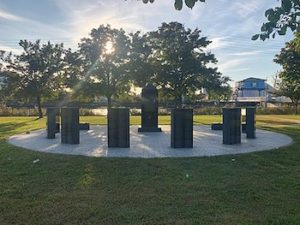
29th Infantry Memorial
*The 29th Connecticut Colored Infantry Regiment was organized on this date in 1864.
This infantry regiment served in the Union Army during the American Civil War. The 29th Connecticut Colored Infantry Regiment was organized at Fair Haven, Connecticut, and mustered under the command of Colonel William B. Wooster. Over 1,200 volunteers were recruited, exceeding the regiment's mandated strength, and 400 were used to form the 30th Connecticut Volunteer Infantry Regiment.
The regiment was attached to the District of Beaufort, Department of the South, from April to August 1864. 1st Brigade, 3rd Division, X Corps, Army of the James, Department of Virginia and North Carolina, to December 1864. 2nd Brigade, 3rd Division, XXV Corps, to January 1865. 2nd Brigade, 1st Division, XXV Corps, to April 1865, District of St. Marys, XXII Corps, Department of Washington, to May 1865. 2nd Brigade, 1st Division, XXV Corps, Department of Texas, to October 1865. The 29th Connecticut Infantry mustered out of service on October 24, 1865, and was discharged at New Haven, Connecticut, on November 25, 1865—the U.S. Department of War’s Bureau of Colored Troops.
Detailed service:
They left Connecticut for Annapolis, Maryland, on March 19. Moved to Beaufort, South Carolina, April 8–13 and have duty there until August 8. Moved from Beaufort, South Carolina, to Bermuda Hundred, Virginia, August 8–13, 1864. Siege operations against Petersburg and Richmond, August 13, 1864, to April 2, 1865. Demonstration on North Side of the James River, August 13–20, 1864. Deep Bottom, Strawberry Plains, August 14–18. Duty in the trenches before Petersburg, August 25-September 24. New Market Heights and Fort Harrison, September 28–29. Chaffin's Farm, September 29–30.
Darbytown Road, October 13. Battle of Fair Oaks, October 27–28. Duty in trenches before Richmond until April 1865. Occupation of Richmond, April 3. (First infantry regiment to enter the city.) They moved to City Point on April 18, then to Point Lookout, Maryland, and were on duty there guarding prisoners until May 28. They moved to City Point May 28–30, then sailed for Texas on June 10, arriving at Brazos, Santiago on July 3. March to Brownsville and duty there until October. At New Orleans, October 27-November 11.
Casualties:
The regiment lost 198 men during service; 1 officer and 44 enlisted men were killed or mortally wounded, and one officer and 152 died of disease. They were part of the overall United States Colored Troops (USCT). They are credited as being the first infantry regiment to enter Richmond, Virginia, when the city surrendered in the Siege of Petersburg.